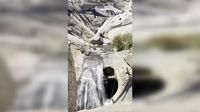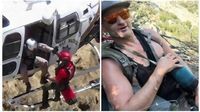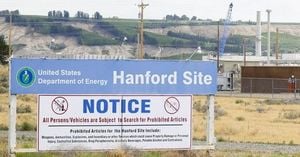Ryan Wardwell, a 46-year-old canyoneer from Long Beach, found himself in a life-or-death struggle last weekend after a routine adventure at California’s Seven Teacups waterfall took a harrowing turn. What began as a planned day of rappelling with friends in the Sequoia National Forest ended with Wardwell trapped behind a roaring waterfall for nearly two days—a dramatic ordeal that has since been hailed by authorities as a “stunning survival story.”
According to the Tulare County Sheriff’s Office, Wardwell set out on August 10, 2025, with a group of friends, all experienced in navigating the rugged terrain of the Kern River region. The Seven Teacups, a tiered waterfall along Dry Meadow Creek just before it joins the Kern River, is a magnet for thrill-seekers drawn by its challenging cliffs and dramatic cascades. But as the group reached the top of the falls and surveyed the churning water below, most decided the risk was too great and turned back. Wardwell, confident from previous successful descents, pressed on alone.
Before leaving the area, his friends left a note on Wardwell’s car with a simple but ominous instruction: if the vehicle was still parked there the next day, someone should alert authorities. That precaution would become crucial. As the hours passed and Wardwell failed to return, concern mounted. By August 11, when his car remained unmoved, a missing person report was filed, and the search began in earnest.
The initial rescue effort was a race against time and nature. Search teams from the Tulare County Sheriff’s Office deployed aircraft equipped with infrared cameras, hoping to spot any sign of Wardwell amid the jagged rocks and dense foliage. But as daylight faded, the operation had to be paused, leaving Wardwell to endure another night trapped behind the relentless curtain of water.
Wardwell’s predicament was as perilous as it was unusual. While rappelling down the cliffside, the “extreme hydraulics” of the waterfall—powerful currents generated by the force of the water—had knocked him off his rope and swept him into a dark, cave-like space behind the cascade. The force of the river had pinned him there, making any attempt at escape impossible. Tulare County Sheriff’s Office Captain Kevin Kemmerling explained the gravity of the situation: “There was nothing he could do to break through.”
By the morning of August 12, searchers redoubled their efforts. This time, they deployed a drone capable of flying close to the waterfall’s base, using both visual and infrared technology. The breakthrough came when the drone’s camera spotted a figure huddled behind the torrent—Wardwell, conscious but visibly weak from his ordeal. The rescue team quickly called in California Highway Patrol’s helicopter H-40 to execute what would be a delicate and dangerous extraction.
California Highway Patrol flight officer paramedic Mike Crain was among those tasked with the rescue. “I had to be careful not to drag him through the waterfall, risk getting him wet, and then a slip hazard,” Crain recounted, emphasizing the treacherous conditions. In a dramatic video released by the Sheriff’s Office, the helicopter hovers low over the narrow canyon as a member of the rescue team is lowered down to reach Wardwell. The team secured him and, in a tense few moments, hoisted him up and away from the pounding water to safety.
Once out of immediate danger, Wardwell was flown to a nearby landing zone. There, medical personnel treated him for minor injuries and dehydration—remarkably, the only physical toll after two days exposed to the elements and the constant spray of the waterfall. He was soon reunited with his family, shaken but alive.
Wardwell later admitted his astonishment at how quickly things had gone wrong. Despite having successfully rappelled the Seven Teacups on previous occasions, he was caught off guard by the sheer power of the water that day. “I got the impression that maybe [Wardwell] didn’t know if he was ever going to get out of there,” paramedic Mike Crain told the San Francisco Chronicle. Wardwell’s own experience underscores the unpredictable and often unforgiving nature of extreme outdoor activities, even for those who consider themselves seasoned adventurers.
The coordinated response from ground teams, drone operators, and air rescue personnel was widely credited with ensuring the best possible outcome. The Sheriff’s Office, reflecting on the operation, used the incident as a teaching moment for anyone drawn to California’s wild places. “Respect the mountains,” Crain advised. “It’s beautiful, but it’s dangerous, and you could die up there very easily.” The department’s official statement echoed that sentiment, reminding the public “to always be aware of their environment and capabilities, especially when navigating white water rivers.”
The Seven Teacups and the broader Kern River region are renowned for their beauty and allure—but also for the hazards they present. The area’s rocky terrain, unpredictable water flows, and shifting weather conditions make it a favorite for experienced hikers and climbers, but also a frequent site of rescues and, tragically, fatalities. Just last spring, a rescue team spent 30 hours searching for a missing elderly hiker in the same region, a mission that even drew the attention of comedian Jay Leno, who happened to be in the area at the time.
Wardwell’s survival, while remarkable, is a stark reminder that adventure in the wild comes with inherent risks. The use of advanced technologies—drones, infrared cameras, and skilled helicopter crews—proved decisive in this case, but not every story ends so well. Authorities stress that preparation, caution, and respect for the elements are essential for anyone venturing into such challenging environments.
For now, Ryan Wardwell’s story stands as a testament to human resilience, the power of teamwork, and the vital role of technology in modern search and rescue operations. His ordeal behind the waterfall may have lasted two days, but the lessons it offers will likely endure far longer among California’s outdoor community and beyond.





